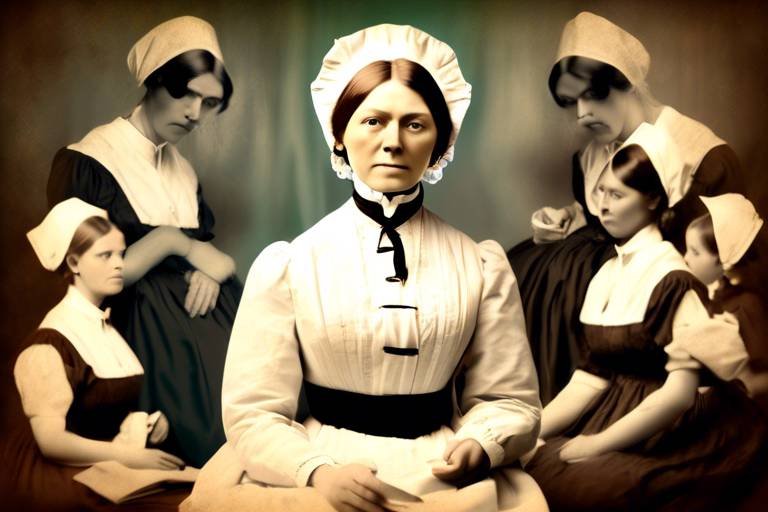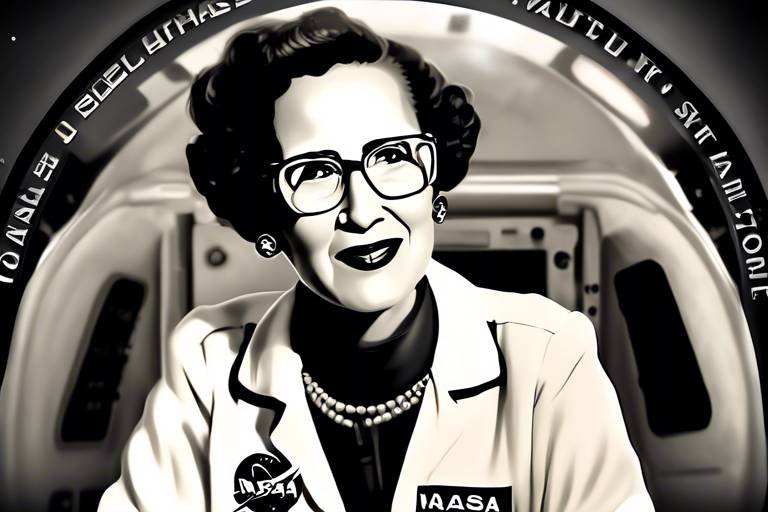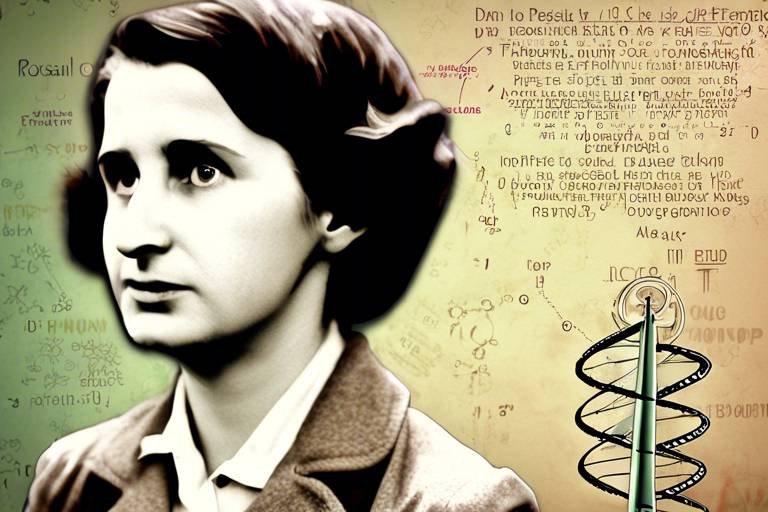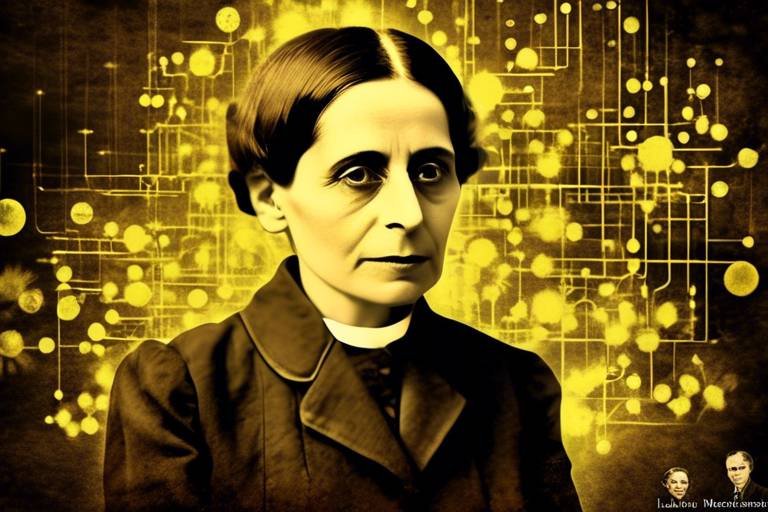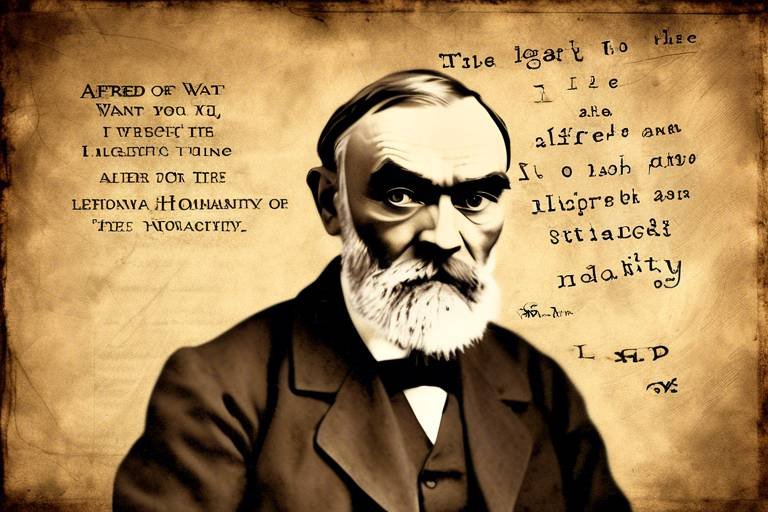The Work of Florence Nightingale and Nursing Reform
Florence Nightingale, often referred to as the founder of modern nursing, made profound contributions that reshaped the healthcare landscape. Her work not only transformed nursing practices but also laid the groundwork for healthcare reform that we still benefit from today. Imagine a time when hospitals were more like battlefields than places of healing—Nightingale stepped into this chaos and emerged as a beacon of hope and change. Through her innovative practices, statistical insights, and relentless advocacy for improved sanitary conditions, she revolutionized the way we think about nursing and patient care. Her legacy is not just a chapter in history; it's a continuous thread woven into the fabric of modern healthcare.
Born in 1820 into a wealthy British family, Florence Nightingale was raised in an environment that emphasized education and social responsibility. However, her aspirations to become a nurse were met with resistance, as nursing was not considered a respectable profession for women of her social standing. Despite the societal norms of her time, Nightingale's passion for serving others propelled her to pursue nursing. She received formal training in Germany, where she honed her skills and developed a deep understanding of patient care. This education was not merely academic; it was the foundation upon which she would build her revolutionary ideas about nursing and healthcare reform.
When the Crimean War broke out, Nightingale seized the opportunity to put her training into practice. She led a group of nurses to the front lines, where they faced unsanitary conditions and a staggering number of wounded soldiers. Nightingale's unwavering dedication and meticulous attention to hygiene drastically reduced the mortality rate in military hospitals. Before her intervention, the death toll was alarmingly high due to preventable diseases. Through her efforts, she improved sanitary conditions, which not only saved lives but also changed the perception of nursing as a vital profession.
One of Nightingale's most significant contributions was her pioneering use of statistics to advocate for healthcare reform. She understood that numbers could tell a powerful story, and she used data visualization techniques to illustrate the dire need for improvements in hospital conditions. Nightingale collected data meticulously and presented it in a way that was accessible to the public and policymakers alike. Her innovative approach was groundbreaking, as it demonstrated that nursing could be informed by scientific evidence rather than mere tradition.
The Polar Area Diagram, often referred to as the "Nightingale Rose Diagram," was a revolutionary tool that showcased the impact of sanitary conditions on soldier mortality. This visual representation made it clear that most deaths were due to preventable diseases rather than battle injuries. The diagram was instrumental in influencing public health policies and hospital management, paving the way for reforms that prioritized hygiene and patient care.
Nightingale's emphasis on data collection and analysis transformed nursing into a science. By advocating for a systematic approach to healthcare, she fostered evidence-based practices that continue to shape the medical field today. Her work encouraged future generations of nurses to rely on research and data, ensuring that patient care is grounded in proven methods rather than outdated practices.
Recognizing the need for formal education in nursing, Nightingale established the first nursing school at St. Thomas' Hospital in London. This institution emphasized the importance of training and professional standards, elevating nursing to a respected profession. Her vision for nursing schools created a ripple effect, leading to the establishment of similar institutions worldwide. Nightingale's legacy is evident in the rigorous training that nurses undergo today, ensuring high standards of care across the globe.
The reforms initiated by Nightingale revolutionized nursing practices, setting new standards for hygiene, patient care, and professional qualifications. Her focus on cleanliness and sanitation was not just about keeping things tidy; it was about saving lives. Today, the principles she advocated for are foundational to modern nursing practices and infection control measures. Nightingale's influence extends beyond her lifetime, as her teachings continue to resonate in nursing education and practice around the world.
Hygiene and sanitation were at the core of Nightingale's philosophy. She understood that a clean environment was essential for healing. Her insistence on proper sanitation transformed hospital practices, leading to better patient outcomes. Hospitals began to adopt her guidelines, which included proper ventilation, clean linens, and regular handwashing. These principles are now integral to infection control protocols in healthcare settings globally, illustrating the lasting impact of her work.
Nightingale was a vocal advocate for professional standards in nursing. She believed that only qualified nurses should provide care, which ultimately led to the establishment of nursing licensure and ethical practices in healthcare. Her efforts ensured that nursing became a respected profession, attracting individuals dedicated to patient care and safety. This advocacy laid the groundwork for the professional standards we uphold in nursing today.
- What was Florence Nightingale's most significant contribution to nursing? Nightingale's most significant contribution was her emphasis on hygiene and sanitation, which drastically reduced mortality rates in hospitals.
- How did Nightingale use statistics in her work? She used statistics to highlight the need for healthcare reform, employing innovative data visualization techniques to advocate for better sanitary conditions.
- What impact did Nightingale have on nursing education? Nightingale established the first nursing school, promoting formal education and training that elevated nursing as a respected profession.

Early Life and Education
Florence Nightingale was born on May 12, 1820, in Florence, Italy, to a wealthy British family. Her upbringing was filled with privilege, but it was her innate desire to help others that set her apart from her peers. Growing up in a time when women were often expected to conform to societal norms, Florence found herself drawn to the field of nursing—a profession that was not only undervalued but also riddled with challenges. Her family, particularly her parents, were initially opposed to her aspirations, believing that nursing was not a suitable career for a woman of her status.
Despite the resistance, Nightingale pursued her education with fervor. She received a well-rounded education, which included subjects such as mathematics, literature, and languages. She was particularly influenced by her father, who encouraged her intellectual pursuits. As she grew older, Florence became increasingly aware of the dire conditions faced by the sick and the poor, which fueled her passion for reforming healthcare practices. In 1850, she made a pivotal decision to train as a nurse at the Kaiserwerth Institute in Germany, where she gained practical experience and honed her skills. This experience was crucial, as it exposed her to the systematic approach to patient care and the importance of hygiene and sanitation in nursing.
Upon her return to England, Nightingale's mission became clear: she aimed to transform nursing into a respected profession through education and reform. She believed that formal training was essential for nurses, and this belief led her to establish the first official nursing school, the Nightingale School of Nursing, at St. Thomas' Hospital in London in 1860. This institution was revolutionary, as it emphasized not just hands-on experience but also the importance of theoretical knowledge in nursing. The curriculum included subjects such as anatomy, physiology, and hygiene, ensuring that nurses were well-equipped to provide high-quality care.
Through her educational initiatives, Nightingale laid the groundwork for the modern nursing profession. She championed the idea that nursing was a science as much as it was an art, advocating for a systematic approach to patient care. Her emphasis on education and training helped elevate the status of nursing, making it a respectable career choice for women. Today, the principles she established continue to guide nursing education and practice, highlighting the enduring legacy of her early life and education.

Contributions During the Crimean War
Florence Nightingale's contributions during the Crimean War were nothing short of revolutionary. Arriving in 1854, she found a chaotic and unsanitary environment in military hospitals, where soldiers were suffering not only from their injuries but also from preventable diseases. The dire conditions were a ticking time bomb, with mortality rates soaring due to poor hygiene and lack of proper medical care. Nightingale's commitment to improving these conditions was fueled by her passion for nursing and her unwavering belief that healthcare should be accessible and effective for all.
With a small team of nurses under her command, Nightingale implemented systematic reforms that dramatically changed the landscape of military healthcare. She focused on improving sanitary conditions, ensuring that hospitals were clean and well-ventilated. Her efforts included:
- Establishing proper waste disposal methods
- Ensuring adequate nutrition for the patients
- Improving the overall organization of the hospital wards
These initiatives led to a significant drop in the mortality rate from 42% to just 2% in a matter of months. Nightingale’s approach was not merely about treating wounds; it was about understanding the holistic needs of patients. She believed that environmental factors played a crucial role in recovery, a concept that was revolutionary for her time.
Moreover, Nightingale was not just a caregiver; she was also a meticulous observer and record keeper. She collected data on patient outcomes and hospital conditions, which she later used to advocate for reforms in military and civilian healthcare systems. Her statistical insights were groundbreaking. For instance, she created the famous Polar Area Diagram, a visual representation that clearly illustrated the relationship between sanitation and soldier mortality rates. This diagram was a powerful tool that not only communicated her findings but also mobilized public opinion and influenced health policies.
In addition to her practical contributions on the ground, Nightingale's leadership and organizational skills were pivotal. She trained her nurses thoroughly, emphasizing the importance of compassion and competence in patient care. Her efforts established a new standard for nursing practice, transforming it from a largely unregulated field into a respected profession. Nightingale's work during the Crimean War laid the groundwork for what we now recognize as modern nursing, proving that with the right approach and dedication, significant improvements in healthcare are possible even in the most challenging circumstances.
Ultimately, Florence Nightingale's contributions during the Crimean War did not just save lives; they reshaped the future of nursing. Her legacy is a testament to the power of innovation and compassion in healthcare, inspiring generations of nurses to follow in her footsteps and continue her mission of improving patient care worldwide.

Statistical Innovations
Florence Nightingale was not just a nurse; she was a trailblazer in the realm of statistics, transforming how healthcare data was understood and utilized. In a time when data was often overlooked, Nightingale harnessed the power of numbers to advocate for significant reforms in nursing practices. Her innovative approach to statistical analysis was revolutionary and laid the groundwork for evidence-based medicine, which is now a cornerstone of modern healthcare.
One of her most notable contributions was her use of data visualization techniques. Nightingale understood that presenting data in a compelling way could influence public opinion and policy. She famously created the Polar Area Diagram, a circular graph that illustrated the causes of mortality among soldiers during the Crimean War. This graphic not only showcased the dire sanitary conditions of military hospitals but also highlighted how these conditions directly correlated with the high mortality rates. The impact of this diagram was profound; it was a visual call to action that spurred reforms in military and civilian healthcare alike.
In addition to the Polar Area Diagram, Nightingale was a pioneer in the systematic collection of data. She meticulously documented patient outcomes, sanitation practices, and hospital conditions, creating a comprehensive database that informed her conclusions. Her emphasis on data-driven decision-making transformed nursing from a largely intuitive practice into a science grounded in evidence. This shift was crucial, as it provided a framework for future nurses and healthcare professionals to follow, ensuring that patient care was based on proven methods rather than mere tradition or anecdote.
The implications of Nightingale's statistical innovations extend far beyond her lifetime. Today, healthcare professionals utilize similar methodologies to analyze patient data, track disease outbreaks, and improve healthcare delivery systems. Her legacy is evident in the rigorous training that nurses receive in statistics and research methods, preparing them to contribute to ongoing improvements in patient care.
Through her groundbreaking work in statistics, Florence Nightingale not only changed the landscape of nursing but also established a new paradigm for how healthcare systems could be improved through data. Her ability to merge nursing with statistical science was a game-changer, proving that numbers could tell compelling stories that drive change. As we continue to face challenges in healthcare today, her pioneering spirit serves as a reminder of the power of data in shaping a better future.
- What was Florence Nightingale's most significant contribution to nursing?
Her most significant contribution was the establishment of nursing as a respected profession through her emphasis on formal education, hygiene, and statistical analysis.
- How did Nightingale use statistics to improve healthcare?
Nightingale used statistics to analyze patient outcomes and hospital conditions, creating visual representations of data that highlighted the need for reforms, particularly in sanitation.
- What is the Polar Area Diagram?
The Polar Area Diagram is a circular graph that Nightingale created to illustrate the causes of soldier mortality during the Crimean War, emphasizing the impact of sanitary conditions.
- Why is evidence-based practice important in nursing?
Evidence-based practice ensures that patient care is grounded in research and data, leading to improved outcomes and more efficient healthcare delivery.

Polar Area Diagram
The , often referred to as the "Nightingale Rose," is one of Florence Nightingale's most remarkable contributions to the field of nursing and public health. This innovative graphical representation was not just a tool for data visualization; it was a powerful medium for storytelling and advocacy. Imagine being able to take complex data and transform it into a visual narrative that could evoke emotion and spur action. That’s exactly what Nightingale did with her diagram.
At its core, the Polar Area Diagram illustrated the relationship between sanitary conditions and soldier mortality during the Crimean War. Each segment of the diagram represented a month, with the area of each segment corresponding to the number of deaths. Nightingale used different colors to differentiate between deaths caused by preventable diseases and those caused by wounds. This visual contrast was striking and made a compelling case for the need for sanitary reforms in military hospitals.
What makes the Polar Area Diagram so special is not just its aesthetic appeal but its ability to convey critical information at a glance. Nightingale understood that numbers alone can be overwhelming and often fail to communicate urgency effectively. By employing a circular format, she allowed viewers to see the data in a way that was both intuitive and impactful. It was a perfect example of how data-driven decision-making could be made accessible to policymakers and the general public alike.
To further illustrate this, let’s consider a simple table that compares the mortality rates before and after implementing sanitary reforms in military hospitals:
| Time Period | Mortality Rate (%) | Sanitary Conditions |
|---|---|---|
| Before Reforms | 42% | Poor |
| After Reforms | 2% | Improved |
This table succinctly summarizes the dramatic impact of Nightingale's reforms. The stark reduction in mortality rates is a testament to her work and the effectiveness of her advocacy. The Polar Area Diagram served not only as a tool for data representation but also as a rallying cry for change. It highlighted the urgent need for improved sanitary conditions, ultimately leading to reforms that saved countless lives.
In conclusion, the Polar Area Diagram exemplifies Florence Nightingale's genius in combining statistical analysis with compelling visual storytelling. It was a groundbreaking approach that not only advanced the field of nursing but also laid the foundation for modern public health policies. Nightingale's ability to turn data into action is a lesson that resonates even today, reminding us of the power of effective communication in driving change.

Data-Driven Decision Making
Florence Nightingale was not just a nurse; she was a visionary who understood the power of data in transforming healthcare. In an era when intuition often guided medical practices, Nightingale boldly championed the use of statistical analysis to uncover the truth behind healthcare outcomes. Imagine walking into a hospital where decisions are made based on gut feelings rather than solid evidence—chaotic, right? Nightingale's approach turned that chaos into a structured, evidence-based practice that would revolutionize nursing.
During her time at the Crimean War, she meticulously collected data on soldier mortality rates, correlating them with various factors such as sanitation and nutrition. This wasn’t just a casual observation; it was a systematic collection of data that laid the foundation for her arguments. Nightingale’s emphasis on was groundbreaking, as she proved that healthcare could be improved through scientific methods. Her work demonstrated that by analyzing data, healthcare professionals could identify patterns and make informed decisions that directly impacted patient outcomes.
To illustrate her findings, Nightingale developed innovative visual tools, such as the Polar Area Diagram. This diagram was not just a pretty picture; it was a powerful communication tool that showcased the stark reality of the conditions in military hospitals. By presenting data visually, she made the information accessible and understandable not only to healthcare professionals but to policymakers and the public as well. It was a game-changer in how data could be used to advocate for reform.
Furthermore, Nightingale's insistence on rigorous data collection established nursing as a profession grounded in science rather than mere caregiving. She believed that nurses should be trained to collect and analyze data, fostering a culture of evidence-based practice that is still prevalent in nursing today. This shift not only enhanced the quality of care provided to patients but also elevated the status of nursing as a respected profession.
In modern healthcare, the principles that Nightingale championed continue to resonate. The emphasis on is now a cornerstone of medical practice, where healthcare providers utilize electronic health records, patient surveys, and clinical research to inform their decisions. The legacy of Nightingale's pioneering work in statistics is evident in the way healthcare systems around the world prioritize data to improve patient care and outcomes.
In conclusion, Florence Nightingale's commitment to data-driven decision making not only transformed nursing practices in her time but also set the stage for future generations of healthcare professionals. Her innovative approach to using data as a tool for improvement has left an indelible mark on the healthcare landscape, ensuring that patient care is always informed by the best available evidence.

Establishment of Nursing Schools
Florence Nightingale’s vision for nursing went beyond just providing care; she sought to transform nursing into a respected profession with formal education and training. In the mid-19th century, the concept of nursing lacked structure and recognition, often seen as a role filled by untrained individuals. Nightingale understood that to elevate the profession, a systematic approach to education was essential. This realization led to the establishment of the first secular nursing school, the Nightingale School of Nursing, at St. Thomas' Hospital in London in 1860.
The Nightingale School was revolutionary. It not only provided nurses with practical training but also emphasized the importance of theoretical knowledge. This dual approach ensured that nurses were not only skilled in patient care but also understood the principles underlying their practices. The curriculum included subjects such as anatomy, physiology, hygiene, and ethics, which were crucial for developing competent healthcare professionals. Nightingale's model became a blueprint for nursing education worldwide, influencing the creation of nursing schools in various countries.
Moreover, Nightingale's emphasis on the importance of hygiene and sanitation was integrated into the training programs, reflecting her belief that a nurse’s role was pivotal in preventing disease and promoting health. The impact of these schools was profound, as they produced a new generation of nurses who were educated, skilled, and dedicated to patient care. As a result, nursing began to gain respect as a profession, attracting individuals who were motivated by a desire to make a difference in the healthcare field.
To illustrate the significance of Nightingale's contributions, consider the following table that outlines key milestones in nursing education:
| Year | Milestone |
|---|---|
| 1860 | Establishment of the Nightingale School of Nursing at St. Thomas' Hospital |
| 1873 | First three nursing schools in the United States inspired by Nightingale's model |
| 1893 | Formation of the National League for Nursing Education in the U.S. |
| 1916 | Introduction of the first nursing licensure laws in the U.S. |
Through her relentless advocacy and innovative ideas, Nightingale not only established nursing schools but also laid the groundwork for a structured nursing profession. Her influence can still be seen today, as nursing education continues to evolve, incorporating advanced practices and technologies while maintaining the core principles she championed. The legacy of Florence Nightingale is not just in the hospitals that bear her name but in the hearts and minds of every nurse who walks the halls of healthcare facilities around the world.
- What was Florence Nightingale's main contribution to nursing?
Florence Nightingale is best known for establishing nursing as a respected profession and for her pioneering work in nursing education and hygiene practices during the Crimean War. - How did Nightingale's work influence modern nursing?
Nightingale's emphasis on formal education, sanitation, and statistical analysis laid the foundation for evidence-based nursing practices that are still in use today. - What is the significance of the Nightingale Pledge?
The Nightingale Pledge, created in 1893, is a modified version of the Hippocratic Oath and serves as a commitment to ethical nursing practice, emphasizing the importance of patient care and professional integrity.

Impact on Nursing Practices
Florence Nightingale's reforms have had a profound and lasting impact on nursing practices, shaping the profession into what we recognize today. Her emphasis on hygiene, patient care, and professional standards revolutionized the way nurses approach their work, leading to significant improvements in patient outcomes across the globe. Nightingale understood that nursing was not just about providing care but also about creating an environment conducive to healing. This understanding was a game-changer in the healthcare sector.
One of the cornerstones of Nightingale's impact was her relentless focus on hygiene and sanitation. She believed that a clean environment was essential for recovery, especially in hospitals where patients were often vulnerable. Her advocacy for proper sanitation practices led to the implementation of strict hygiene protocols in medical facilities. To illustrate her points, she often used statistics and data to showcase the correlation between cleanliness and patient recovery rates. This data-driven approach laid the groundwork for modern infection control practices that are now standard in healthcare settings.
Moreover, Nightingale's push for professional standards in nursing cannot be overstated. Before her time, nursing was often seen as a lowly profession, lacking formal training and respect. By establishing nursing schools and advocating for rigorous training programs, Nightingale elevated the status of nursing to a respected profession. Her work led to the creation of the first formal nursing education program at St. Thomas' Hospital in London, setting a precedent for nursing schools worldwide. This shift not only improved the quality of care provided to patients but also instilled a sense of pride and professionalism among nurses.
To better understand the impact of Nightingale's reforms on nursing practices, consider the following table:
| Aspect of Nursing | Before Nightingale | After Nightingale |
|---|---|---|
| Hygiene Practices | Minimal emphasis on cleanliness | Strict sanitation protocols |
| Nursing Education | No formal training | Structured nursing programs established |
| Professional Recognition | Low status, often untrained | Respected profession with licensure |
In addition to hygiene and education, Nightingale also championed the importance of patient-centered care. She believed that understanding the patient's needs and emotional well-being was just as crucial as the physical aspects of care. This holistic approach encouraged nurses to develop strong relationships with their patients, fostering trust and communication. Today, patient-centered care remains a fundamental principle in nursing, emphasizing the importance of treating the individual rather than just the illness.
Nightingale's influence extends far beyond her lifetime; her principles continue to guide nursing practices today. The emphasis on evidence-based practices, rigorous training, and a commitment to patient care are all legacies that stem from her work. As we look to the future of healthcare, it's essential to remember that the foundations laid by Nightingale are what allow nurses to provide high-quality care in an ever-evolving medical landscape.
- What were Florence Nightingale's main contributions to nursing?
Florence Nightingale is best known for her work during the Crimean War, where she improved sanitary conditions in hospitals, significantly reducing mortality rates. She also established formal nursing education and promoted hygiene practices. - How did Nightingale influence modern nursing?
Nightingale's emphasis on data, hygiene, and professional standards transformed nursing into a respected profession. Her principles of patient-centered care and evidence-based practices continue to shape nursing education and practice today. - What is the significance of the Polar Area Diagram?
The Polar Area Diagram, created by Nightingale, visually represented the impact of sanitary conditions on soldier mortality during the Crimean War. It was a groundbreaking tool that influenced public health policies and hospital management.

Hygiene and Sanitation
Florence Nightingale's unwavering commitment to revolutionized the way healthcare was delivered during her time and laid the foundation for modern nursing practices. Imagine walking into a hospital where the air is thick with the stench of uncleanliness, where patients are more likely to succumb to infections than the ailments that brought them there. Nightingale recognized that the environment played a crucial role in patient recovery, and she was determined to change that narrative.
During the Crimean War, Nightingale was horrified by the appalling sanitary conditions in military hospitals. She observed that soldiers were not only suffering from battle wounds but were also falling ill due to unsanitary practices. Her mission was clear: to improve hygiene and sanitation to save lives. She implemented rigorous cleaning protocols, improved ventilation, and ensured that patients had access to clean water and proper nutrition. The results were staggering; mortality rates plummeted, showcasing the direct correlation between cleanliness and health outcomes.
To further emphasize her findings, Nightingale meticulously documented her observations and outcomes. She created a systematic approach to hygiene, which included:
- Regular cleaning of hospital wards
- Proper disposal of waste
- Ensuring adequate ventilation
- Providing nutritious food
- Encouraging handwashing among staff
These practices not only improved the conditions for patients but also set a new standard for healthcare facilities. Nightingale's advocacy led to the establishment of guidelines that prioritized hygiene, which are still in use today. She understood that cleanliness was not just a matter of aesthetics but a fundamental aspect of patient care that could not be overlooked.
Furthermore, her work prompted a shift in how healthcare professionals viewed their responsibilities. Nurses were no longer seen merely as caretakers but as essential players in the healthcare system, responsible for maintaining a clean and safe environment for their patients. This was a significant transformation, as it elevated the nursing profession and instilled a sense of pride and accountability among nurses.
In summary, Florence Nightingale's focus on hygiene and sanitation was not just a reaction to the conditions of her time; it was a groundbreaking movement that forever changed the landscape of nursing and healthcare. Her legacy lives on, reminding us that a clean environment is vital for healing, and her principles continue to influence infection control practices in hospitals worldwide.
- What were Florence Nightingale's main contributions to nursing?
Florence Nightingale is best known for her role in improving hygiene and sanitation in hospitals, establishing nursing schools, and using statistical analysis to advocate for healthcare reform. - How did Nightingale's work impact modern nursing?
Her emphasis on hygiene, patient care, and professional standards laid the groundwork for nursing as a respected profession, influencing nursing education and practices globally. - What is the Polar Area Diagram?
The Polar Area Diagram, created by Nightingale, visually represented the impact of sanitary conditions on soldier mortality, highlighting the need for healthcare reform.

Advocacy for Professional Standards
Florence Nightingale was not just a nurse; she was a visionary who understood that for nursing to be recognized as a true profession, it needed a foundation built on professional standards. In her time, nursing was often seen as a lowly occupation, filled primarily by women who had little to no formal training. Nightingale challenged this perception head-on. She believed that qualified nurses, trained through rigorous education, could significantly improve patient care and healthcare outcomes. This belief propelled her to advocate for a more structured approach to nursing education and practice.
To lay the groundwork for these professional standards, Nightingale emphasized the importance of formal training. She established the Nightingale Training School for Nurses at St. Thomas' Hospital in London in 1860. This institution was revolutionary, as it was one of the first to provide systematic education for nurses, teaching them not only practical skills but also the theoretical knowledge necessary for effective patient care. The curriculum included subjects like anatomy, physiology, and hygiene, which were essential for understanding the complexities of patient health.
Moreover, Nightingale's advocacy was not limited to the education of nurses; she also championed the idea of licensure. She argued that only those who had undergone proper training should be allowed to practice nursing. This was a radical idea at the time, but it was a crucial step towards establishing nursing as a respected profession. By advocating for licensure, Nightingale aimed to ensure that all nurses met a certain standard of competency, which would, in turn, enhance the quality of care provided to patients.
Nightingale's influence extended beyond her immediate environment. Her ideas began to resonate globally, leading to the establishment of similar nursing schools worldwide. As a result, the professionalization of nursing gained momentum, and the standards she set became a benchmark for nursing education. Today, we can see the lasting impact of her work in the rigorous training programs and licensure requirements that exist for nurses around the world.
In summary, Florence Nightingale's advocacy for professional standards was a game-changer for the nursing profession. Through her efforts, she not only elevated the status of nursing but also ensured that patients received care from qualified professionals. Her vision continues to inspire nurses today, reminding us that the pursuit of excellence in healthcare is a journey worth undertaking.
- What were Florence Nightingale's main contributions to nursing?
Florence Nightingale's main contributions include the establishment of nursing schools, the promotion of hygiene and sanitation in healthcare, and the use of statistical data to improve patient care. - How did Nightingale influence nursing education?
Nightingale influenced nursing education by founding the Nightingale Training School, which emphasized formal training and established a curriculum that included both practical and theoretical components. - What is the significance of nursing licensure?
Nursing licensure ensures that only qualified individuals can practice nursing, thereby protecting patients and maintaining high standards of care within the profession. - How does Nightingale's legacy continue to impact nursing today?
Nightingale's legacy continues to impact nursing through the ongoing emphasis on education, professionalism, and evidence-based practices in healthcare.
Frequently Asked Questions
- What were Florence Nightingale's main contributions to nursing?
Florence Nightingale was a trailblazer in nursing reform, primarily known for her work during the Crimean War, where she dramatically improved sanitary conditions in military hospitals. Her innovative practices, such as emphasizing hygiene and patient care, laid the foundation for modern nursing standards. Additionally, she established nursing schools which elevated the profession and promoted formal education for nurses.
- How did Nightingale use statistics to improve healthcare?
Nightingale was a pioneer in utilizing statistics to drive healthcare improvements. She developed innovative data visualization techniques, including the Polar Area Diagram, which illustrated the connection between sanitary conditions and soldier mortality rates. This approach not only highlighted the urgent need for reform but also influenced public health policies and hospital management practices.
- What impact did Nightingale have on nursing education?
Florence Nightingale's vision for nursing education was revolutionary. She established the first formal nursing schools, which emphasized rigorous training and education for nurses. This initiative helped transform nursing into a respected profession and ensured that nurses were equipped with the necessary skills and knowledge to provide high-quality care.
- Why is hygiene and sanitation important in nursing?
Nightingale's focus on hygiene and sanitation was crucial in transforming hospital environments and improving patient outcomes. Her principles laid the groundwork for modern infection control practices, emphasizing the importance of cleanliness in preventing the spread of diseases and ensuring the health and safety of patients.
- What legacy did Florence Nightingale leave in nursing?
The legacy of Florence Nightingale is profound and enduring. Her advocacy for professional standards, evidence-based practices, and the importance of education in nursing has shaped the profession as we know it today. Nightingale's principles continue to influence nursing education, practice, and healthcare policies around the world.

